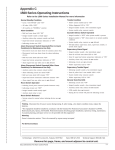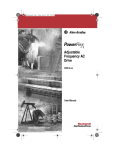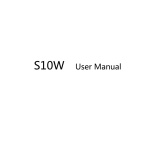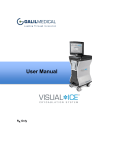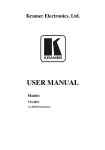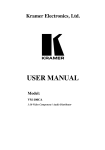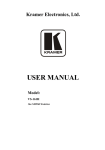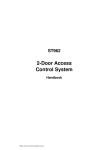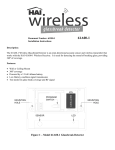Download ESL 2500 User Manual
Transcript
ESL 2500 Keypad Instruction Manual esl a product of sentrol, inc 1 2 TABLE OF CONTENTS 1.0 System Operation ....................................................................................... 4 1.1 The ESL 2500 Keypad ............................................................................... 4 1.2 The Keypad Keys ....................................................................................... 5 1.3 The Keypad Display ................................................................................... 5 1.4 Passcodes ................................................................................................... 6 2.0 Alarm Conditions ....................................................................................... 7 2.1 Identifying Zone Conditions ...................................................................... 7 2.2 Silencing Alarms ........................................................................................ 7 3.0 Trouble Conditions ..................................................................................... 8 3.1 Identifying System Trouble Conditions ..................................................... 8 3.2 Silencing Trouble ....................................................................................... 9 4.0 Programming Menu Mode Options ........................................................... 10 4.1 Programming the System ........................................................................ 10 4.1.1 Programming the BMB .................................................................. 10 4.1.2 Defaulting the BMB ....................................................................... 12 4.1.3 Programming the DAC .................................................................. 13 4.1.4 Programming the Zone Names ..................................................... 14 4.1.5 Tech and User Codes .................................................................... 17 4.2 Connect ................................................................................................... 19 4.3 Event Log ................................................................................................. 19 4.3.1 View Log ....................................................................................... 20 4.3.2 Print Log ....................................................................................... 21 4.3.3 Clear Log ...................................................................................... 22 4.4 Comm Test .............................................................................................. 23 4.5 Lamp Test ................................................................................................ 23 4.6 Set Clock ................................................................................................. 24 5.0 Fire Detection .......................................................................................... 25 5.1 Introduction ............................................................................................ 25 5.2 When an Alarm Occurs ........................................................................... 25 5.3 Resetting the Fire Alarm System ............................................................. 25 5.4 Developing An Evacuation Plan ............................................................... 26 5.5 Fire-Safety Basics .................................................................................... 26 5.6 Know Fire Hazards .................................................................................. 27 5.7 In Case Of Fire ........................................................................................ 27 5.8 Be Prepared ............................................................................................. 27 5.9 Zone Trouble ........................................................................................... 28 Owner’s Insurance Premium Credit Requested ................................................ 29 3 1.0 SYSTEM OPERATION Read these instructions carefully to familiarize yourself with the system. Your system has been customized to meet your specific requirements. If you have questions concerning the features on your system, consult your Fire Protection Representative. Refer to the ESL 2501 Fire Alarm Control Panel Installation Manual 64812711 for installation and configuration information before proceeding. 1.1 THE ESL 2500 KEYPAD D MENU SYSTEM RESET ALARM SILENCE ALM MEM 1 2 3 BYPASS DELAY ARM CHIME 4 5 6 RST SMOKE TEST PROGRAM 7 8 9 QUIT ACCESS INSTANT CLEAR 0 ENTER HOME TROUBLE SILENCE 4 EVENT LOG VIEW INFO NEXT NEXT PREV 1.2 THE KEYPAD KEYS MENU MENU KEY Used to enter the programming mode. SYSTEM RESET KEY SYSTEM RESET Resets the system if the system is in alarm or trouble and forces a battery test. The proper passcode must be entered. ALARM SILENCE ALARM SILENCE KEY TROUBLE SILENCE Silences alarms when the proper passcode is entered. TROUBLE SILENCE KEY Silences all system troubles when the proper passcode is entered. PROGRAMMING KEYS Used in the programming mode for menu and data entry scrolling and passcode entry. CLEAR ENTER NEXT PREV 1.3 THE KEYPAD DISPLAY SYSTEM NORMAL JAN 21 05:27:52 NOTE: To save power, the keypad display will dim and go into screen saver mode after four (4) minutes of no keypresses. Press any key to turn the display back ON. 5 1.4 PASSCODES The ESL 2501 Fire Alarm Control Panel (FACP) uses two passcode levels, technician and user. Each passcode is four digits long. The user passcode allows resetting and silencing the FACP and programming of a limited number of items. The technician passcode also allows full programming of the FACP. Section 4.0 Programming Menu Mode Options details which items are accessible. The default user passcode is: 0 0 0 0 . NOTE: This passcode may have been changed during installation. 6 2.0 ALARM CONDITIONS 2.1 IDENTIFYING ZONE CONDITIONS If a zone causes an alarm, the system status is displayed on the first line. The status of zones in alarm and trouble are displayed on the second line. The top line scrolls all existing system conditions. The second line scrolls the status of all existing system and zone conditions. Multiple system and zone conditions are scrolled alternately on the second line of the display. For complete zone or system status details, view the Event Log. FIRE ALARM ZONE# Position “a”: :ab A if in Fire Alarm S if Supervisory Alarm Position “b”: T if in Trouble W if in Walk-Test M if in Maintenance 2.2 SILENCING ALARMS 1. Press ALARM SILENCE . The Keypad displays: ALARM SILENCE ENTER PASSCODE 2. Enter passcode: . 7 3.0 TROUBLE CONDITIONS 3.1 IDENTIFYING SYSTEM TROUBLE CONDITIONS When your system detects a trouble condition, the Keypad will alternate between displaying System Trouble and any other existing system conditions. The specific trouble messages are alternately displayed on the second line of the display, with each message displayed for two seconds at a time. SYSTEM TROUBLE XXX :T Keypad System Trouble NO AC POWER 8 Description Indicates the loss of AC power or that the AC voltage is not high enough to power the system. LOW BATTERY Indicates that the battery voltage is low or the batteries are missing. BELL Indicates that there is a short or open in the wiring or that the EOL is missing. GROUND FAULT Indicates an earth ground connection to the system. BELL SILENCE Indicates that a bell (NAC) has been silenced. DRILL TEST Indicates that a drill test is being performed. HIBERNATION Indicates that the panel has gone into hibernation mode. LEM/LRM Indicates a problem with the LEM/LRM module. TELCO Indicates a problem with a 2500-DACT phone line. EXPANDER Indicates a missing ZEM module. DAC Indicates a problem with the 1500-DAC2 module. KEYPAD Indicates a missing supervised keypad. RA Indicates a missing supervised RA. COMM Indicates a 2500-DACT communication failure. MEMORY Indicates a function map memory failure. Enter programming mode to clear. 3.2 SILENCING TROUBLE To silence the trouble sounder: 1. Press TROUBLE SILENCE . The Keypad displays: TROUBLE SILENCE ENTER PASSCODE 2. Enter passcode: . After you silence the trouble sounder, the Keypad display will alternate between the system status and the trouble message. 9 4.0 PROGRAMMING MENU MODE OPTIONS Your system has several features which you may be able to program yourself. DO NOT attempt to program the system unless you have been trained on programming procedures and you fully understand these operations. The following menu tree may be scrolled using the programming keys PREV, NEXT, ENTER and CLEAR. MAIN MENU EXIT1,2 PROGRAM SYSTEM1,2 EVENT LOG 2 Exit1,2 Exit2 Program BMB2 View Log2 Program DAC2 CONNECT2 COMM TEST2 LAMP TEST2 Print Log2 Clear Log2 Default BMB2 Default DAC2 Zone Names1,2 Tech Code 2 User Code1,2 1 User Passcode Required 2 Technician Passcode Required 4.1 PROGRAMMING THE SYSTEM 4.1.1 PROGRAMMING THE BMB 1. Press MENU . The Keypad displays: MENU ENTER PASSCODE 2. 10 Enter passcode: . SET CLOCK2 The Keypad displays: MAIN MENU EXIT 3. Press NEXT . The Keypad displays: MAIN MENU PROGRAM SYSTEM 4. Press ENTER . The Keypad displays: PROGRAM SYSTEM EXIT 5. Press NEXT until the Keypad displays: PROGRAM SYSTEM PROGRAM BMB 6. Press ENTER . The Keypad displays: PROGRAM BMB LOC:001 VAL:001 See Section 5.6 Programming Matrix of the ESL 2501 Fire Alarm Control Panel Installation Manual for locations and values. 7. Use the NEXT Press ENTER PREV , PREV and numeric keys to enter the desired location. and the cursor moves to the value field. Use the NEXT , and numeric keys to change the value for the selected location. Press ENTER to accept the new value and advance to the next location. Use CLEAR to move the cursor back to location to select a different location. 11 4.1.2 DEFAULTING THE BMB 1. Press . The Keypad displays: MENU MENU ENTER PASSCODE 2. Enter passcode: . The Keypad displays: MAIN MENU EXIT 3. Press NEXT . The Keypad displays: MAIN MENU PROGRAM SYSTEM 4. Press ENTER . The Keypad displays: PROGRAM SYSTEM EXIT 5. Press NEXT until the Keypad displays: PROGRAM SYSTEM DEFAULT BMB 6. Press ENTER . The Keypad displays: DEFAULT BMB ENTER = COMPLETE 7. Press ENTER to complete operation. See Section 5.6 Programming Matrix of the ESL 2501 Fire Alarm Control Panel Installation Manual for Location and Value settings for the Function Map defaults. 12 4.1.3 PROGRAMMING THE DAC The ESL 1500-DAC2 Digital Alarm Communicator is programmed using the ESL Model 1200-DPG programmer. Refer to the ESL 1500-DAC2 Installation Manual P/N 64812689. 13 4.1.4 PROGRAMMING THE ZONE NAMES 1. Press . The Keypad displays: MENU MENU ENTER PASSCODE 2. Enter passcode: . The Keypad displays: MAIN MENU EXIT 3. Press NEXT . The Keypad displays: MAIN MENU PROGRAM SYSTEM 4. Press ENTER . The Keypad displays: PROGRAM SYSTEM EXIT 5. Press NEXT until the Keypad displays: PROGRAM SYSTEM ZONE NAMES 6. Press ENTER . The Keypad displays: ZONE 01 ZONE 01 14 7. The Keypad will display the zone number selected on the first line and the zone name to be programmed on the second line. Press NEXT Press ENTER or PREV to change the zone number. to edit the displayed zone’s name. 8. Press the key associated with each character listed on the next page to enter in the new zone name. Each keypress will change the display to the next character listed for that key. A maximum of 10 letters (including spaces) may be used for each zone name. 9. Press CLEAR to start over if a mistake is made or press ENTER to save the zone name and return to the zone number prompt. 10. Press CLEAR from the zone number prompt to exit. 15 KEY CHARACTER AVAILABLE 1 0 1 2 2 A B C 3 D E F 4 G H I 5 J K L 6 MN O 7 P Q R 8 T U V 9 WX Y 0 space ! 3 4 5 6 7 8 9: Z [ ¥ ] ^ _ “ # $ % & ‘ ; < = > ? @ S * + , - PREV Used to move the cursor back one position NEXT Used to move the cursor forward one position 16 . / 4.1.5 TECH AND USER CODES 1. Press . The Keypad displays: MENU MENU ENTER PASSCODE 2. Enter passcode: . The Keypad displays: MAIN MENU EXIT 3. Press NEXT . The Keypad displays: MAIN MENU PROGRAM SYSTEM 4. Press ENTER . The Keypad displays: PROGRAM SYSTEM EXIT 5. Press NEXT until the Keypad displays: PROGRAM SYSTEM TECH CODE 6. Press ENTER or PROGRAM SYSTEM USER CODE . The Keypad displays: XXXX ENTER = COMPLETE Where XXXX is the current passcode 17 7. Set the new passcode (see example below) Example: To set the passcode to 1234 Press 8. 18 Press 1 CLEAR 2 to exit or 3 ENTER 4 to save changes. 4.2 CONNECT This option is not available at this time. 4.3 EVENT LOG 1. Press MENU . The Keypad displays: MENU ENTER PASSCODE 2. Enter passcode: . The Keypad displays: MAIN MENU EXIT 3. Press NEXT until the Keypad displays: MAIN MENU EVENT LOG 4. Press ENTER . The Keypad displays: EVENT LOG EXIT 19 4.3.1 VIEW LOG 1. Press MENU . The Keypad displays: MENU ENTER PASSCODE 2. Enter passcode: . The Keypad displays: MAIN MENU EXIT 3. Press NEXT until the Keypad displays: MAIN MENU EVENT LOG 4. Press ENTER . The Keypad displays: EVENT LOG EXIT 5. Press NEXT . The Keypad displays: EVENT LOG VIEW LOG 6. Press ENTER . The Keypad display alternates between: EVENT#: 01 JAN 02 16:15 ZONE 01 FIRE ALARM Event Number and Time/Date Stamp Event Description 7. Event #1 is the last or newest event in the log, not the oldest. 8. Press 20 NEXT or PREV to scroll through all the events. 4.3.2 PRINT LOG 1. Press MENU . The Keypad displays: MENU ENTER PASSCODE 2. Enter passcode: . The Keypad displays: MAIN MENU EXIT 3. Press NEXT until the Keypad displays: MAIN MENU EVENT LOG 4. Press ENTER . The Keypad displays: EVENT LOG EXIT 5. Press NEXT . The Keypad displays: EVENT LOG PRINT LOG 6. Press ENTER . The Keypad displays: PRINT LOG ENTER = COMPLETE 7. Press ENTER . The Keypad displays: EVENT LOG PRINT LOG 21 4.3.3 CLEAR LOG 1. Press MENU . The Keypad displays: MENU ENTER PASSCODE 2. Enter passcode: . The Keypad displays: MAIN MENU EXIT 3. Press NEXT until the Keypad displays: MAIN MENU EVENT LOG 4. Press ENTER . The Keypad displays: EVENT LOG EXIT 5. Press NEXT . The Keypad displays: EVENT LOG CLEAR LOG 6. Press ENTER . The Keypad displays: CLEAR LOG ENTER = COMPLETE 7. Press ENTER . The Keypad displays: EVENT LOG CLEAR LOG 22 4.4 COMM TEST This option is not available at this time. 4.5 LAMP TEST 1. Press MENU . The Keypad displays: MENU ENTER PASSCODE 2. Enter passcode: . The Keypad displays: MAIN MENU EXIT 3. Press NEXT until the Keypad displays: MAIN MENU LAMP TEST 4. Press ENTER . The Keypad displays: LAMP TEST ENTER = COMPLETE 5. Press ENTER . The Keypad will turn on every dot on the display, all the lightable keys, and the piezo for 5 seconds. The keypad will return to normal operation. 23 4.6 SET CLOCK 1. Press . The Keypad displays: MENU MENU ENTER PASSCODE 2. Enter passcode: . The Keypad displays: MAIN MENU EXIT 3. Press NEXT until the Keypad displays: MAIN MENU SET CLOCK 4. Press ENTER . The Keypad displays: 10:53 02/04/1997 ENTER = COMPLETE 5. Set the new time and date. (See example) Example: To set the clock to 2:15 pm on June 17, 1997: Press 1 4 1 5 (2:15 pm) Press 6 0 1 7 1 9 9 (June 17, 1997) 6. Press CLEAR to start over if a mistake is made or press to save changes. 24 ENTER 7 5.0 FIRE DETECTION 5.1 INTRODUCTION All fire systems require regular testing and maintenance. Common dust buildup in smoke detectors can cause them to false alarm or fail in a time of need. Consult your Security Company Representative for a scheduled maintenance program. All devices in a Fire Alarm system should be tested monthly except as described in NFPA 72. 5.2 WHEN AN ALARM OCCURS When a fire alarm occurs, the bell sounds, the keypad(s) produces the fire alarm tone and displays the message “FIRE ALARM” and the fire alarm system zone that initiated the alarm. DO NOT IMMEDIATELY ASSUME IT IS A “FALSE ALARM”! The occupants should respond according to the fire escape plan that has been developed for the building. Only if the person responsible for the building and the safety of its occupants is certain that the alarm has occurred as a result of some other cause, should an occupant silence a fire alarm signal. To silence an alarm signal, the operator presses the ALARM SILENCE key (button) and then enters the passcode. 5.3 RESETTING THE FIRE ALARM SYSTEM After the site has been secured, the source of a fire alarm initiation has been identified and corrected, and the building is deemed safe for occupancy it is necessary to “reset” the fire alarm system. This is necessary because smoke detectors and fire alarm control panels “latch” in the ALARM state until they are intentionally “reset” by an individual with access to the fire alarm system controls. To reset the system depress the SYSTEM RESET key (button) and enter the passcode. The trouble condition should disappear on the zone in a couple of seconds. If the trouble condition does not clear after resetting the smoke detector, contact your Fire Protection Representative for service. 25 5.4 DEVELOPING AN EVACUATION PLAN Preparation and education are of prime importance in the prevention of fire. An evacuation plan should be established BEFORE a severe situation arises. Make sure your Fire Protection Representative fully explains the configuration of your system. Make sure you fully understand the limitations of your system. Use the following steps in establishing an evacuation plan: 1. Evaluate all possible escape routes from your home and draw a floor plan. 2. Select two exit escape routes from each room. 3. Provide escape ladders for rooms above the first floor. Check the ladders to be sure that they will reach the ground. 4. Draw a rough sketch of your escape plan so that everyone is familiar with it. 5. Practice your escape plan to assure that everybody knows what they have to do in a severe situation. 6. Establish a meeting place outside where your family is to report. 7. Advise the local fire authority if you have installed a fire alarm system. Discuss the following with all residents: 1. Familiarity with alarm signals. 2. Status of bedroom doors. 3. Testing of door during a fire and use of alternate escape routes if HOT to touch. 4. Crawling and holding breath techniques during a fire. 5. ESCAPE FAST, DO NOT STOP for packing. 6. Emphasize that no one is to return to a burning building. 5.5 FIRE-SAFETY BASICS The intended purpose of a household fire warning system is to provide a warning sufficiently early in the development of a fire that the occupants are able to escape before conditions become life-threatening. However, a properly designed household fire warning system is just one part of a good fire safety plan for one’s home. The first step is to enhance the fire safety of one’s home with fire prevention. Then, in order to derive the intended benefit from the household fire warning system, the household must have a pre-arranged fire escape plan. 26 5.6 KNOW FIRE HAZARDS No detection device can protect life in all situations. Therefore, safeguards should be taken to avoid such potentially dangerous situations as smoking in bed, leaving children home alone, and cleaning with flammable liquids such as gasoline. The best fire protection is minimizing fire hazards through proper storage of materials and good housekeeping practices. Careless use of combustible materials and electrical appliances overloading electrical outlets are major causes of fire. Explosive and fast burning materials must be eliminated from the home. 5.7 IN CASE OF FIRE Leave immediately! Do not stop to pack or search for valuables. In heavy smoke, hold your breath and stay low - crawl if necessary. The clearest air usually is at the floor. If you have to go through a closed door, carefully feel the door and door knob to see if undue heat is present. If relatively cool, brace your foot against the bottom of the door with your hip against the middle, and one hand against the top edge. Open slightly. If there is a rush of hot air, slam the door quickly and latch it. Unvented fire will build up considerable pressure. Be sure that all members of the household realize this danger. Use your neighbor’s phone or street fire alarm box. The job of extinguishing the fire should be left to the professionals. Too many unforeseen things can occur when inexperienced people try to extinguish a fire. 5.8 BE PREPARED Perform fire drills regularly. Use them to assure recognition of an alarm signal. For your protection, simulate different circumstances (smoke the hall, living room, etc.). Then have everyone react to the situation. Draw a floor plan and show two exits from each room. It is important that children be instructed carefully. Their tendency is to hide in a crisis. It is imperative that one meeting place outside the home be established. You should insist that everyone meet there during an alarm. This will eliminate the tragedy of someone reentering the house for a missing member who is actually safe. If you have small children and/or invalids residing in your household, you can help your fire department by placing decals on bedroom windows. Most fire departments supply the decals. Become familiar with the distinctive sounds of your Fire Alarm signals. 27 5.9 ZONE TROUBLE If a trouble condition for a zone is displayed on your keypad, consult your installer. A trouble condition may result when a fire alarm is silenced and when the smoke detector has not been reset, or when the smoke detector is dirty and needs to be cleaned/serviced. If none of the above apply, the trouble may be due to a wiring problem or a supervisory condition and a service call may be required. 28 OWNER’S INSURANCE PREMIUM CREDIT REQUESTED This form should be completed and forwarded to your homeowner’s insurance carrier for possible premium credit. This control is UL Listed for: UL Household Fire A. General Information Insured’s Name and Address Insurance Co. Policy No: ESL Fire Alarm Control Panel Installed by: Serviced by: B. Notifies (Insert F=Fire) Local Sounding Device: Fire Dept.: Central Station: Name and Address: C. Powered By A.C. With Rechargeable Power Supply (Continued on Reverse) 29 D. Testing Quarterly Monthly Weekly Other E. Smoke Detector Locations Furnace Room Kitchen Bedrooms Attic Basement Living Room Dining Room Hall Other F. Additional Pertinent Information Signature: 30 Date: 31 SENTROL, INC 12345 SW Leveton Dr., Tualatin, OR 97062 Tel.: 503.692.4052 Fax: 503.691.7566 http://www.sentrol.com ESL a p r o d u ct 32 of sentrol, inc U.S. & Canada: 800.547.2556 Technical Service: 800.648.7424 FaxBack: 1.800.483.2495 Sentrol reserves the right to change specifications without notice. ©1996 Sentrol, ©1997 Sentrol,Inc. Inc. 64812808B

































